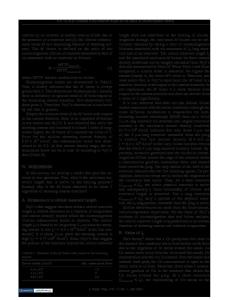Reservoir effect and the role of low current density regions on electromigration lifetimes in copper interconnects
- PDF / 238,729 Bytes
- 5 Pages / 585 x 783 pts Page_size
- 97 Downloads / 311 Views
Hongyu Li Institute of Microelectronics, Singapore 117685
K.N. Tu Department of Materials Science and Engineering, University of California—Los Angeles, Los Angeles, California 90095-1595
A.M. Gusak Cherkasy National University, Cherkasy 18017, Ukraine (Received 19 February 2006; accepted 18 April 2006)
Electromigration (EM) in copper dual-damascene interconnects with extensions (also described as overhang regions or reservoirs) in the upper metal (M2) were investigated. It was found that as the extension length increases from 0 to 60 nm, the median-time-to-failure increased from 50 to 140 h, representing a ∼200% improvement in lifetimes. However, further increment of the extension length from 60 to 120 nm did not result in any significant improvement in EM lifetimes. Based on calculations of current densities in the reservoir regions and recently reported nucleation, void movement, and agglomeration-based EM phenomena, it is proposed that there is a critical extension length beyond which increasing extension lengths will not lead to longer EM lifetimes.
I. INTRODUCTION
It is well known that the interfacial diffusion at Cu/ Si3N4 interfaces adversely affects the electromigration (EM) lifetime in Cu interconnects, in contrast to grainboundary diffusion in Al alloy conductors.1,2 Considerable attention has been paid to modify this interface to improve EM lifetime. Some researchers have used different cap materials,3–5 and others have proposed different process treatments prior to the deposition of the dielectric cap.6 Another good choice for delaying the EM failure is to introduce an extension (also described as overhang region or reservoir) in the interconnects.7 It is thought that the extension serves as a reservoir for void growth, thus prolonging the median time to failure. Recently, the reservoir effect in Al–Cu interconnect with W vias was reported,8,9 where voids are generally initiated at the W/Al interface by large Al atomic flux divergence. Lower levels of stress and vacancy concentration in the longer reservoir were proposed to contribute to the better electromigration reliability of interconnects. However,
a)
Address all correspondence to this author. e-mail: [email protected] DOI: 10.1557/JMR.2006.0270 J. Mater. Res., Vol. 21, No. 9, Sep 2006
http://journals.cambridge.org
Downloaded: 15 Mar 2015
the reservoir mechanism in dual-damascene Cu interconnects is clearly different from that of W/Al via structures because voids nucleate at the Cu/Si3N4 interface far from the cathode and move along the interface.10 Because of the technological importance of dual-damascene Cu interconnects, it is necessary to understand how extension lengths impact electromigration lifetimes. In this work, the reservoir effect and the role of low current density regions on electromigration lifetimes in Cu dualdamascene interconnects were investigated. II. EXPERIMENTAL
Test structures consisting of M1 and M2 via-fed structures (Fig. 1) were fabricated using 0.18 m Cu/oxide damascene technology. M2 trench and via were
Data Loading...











